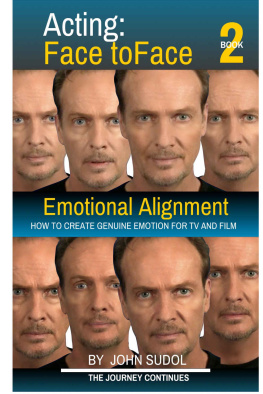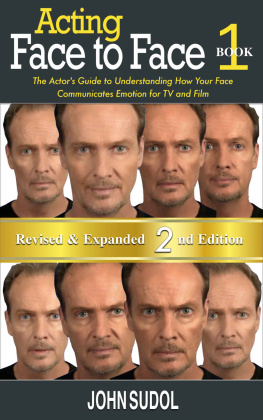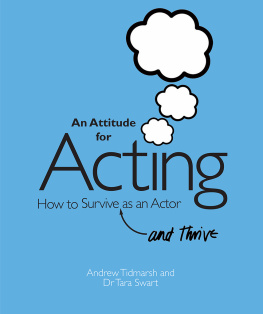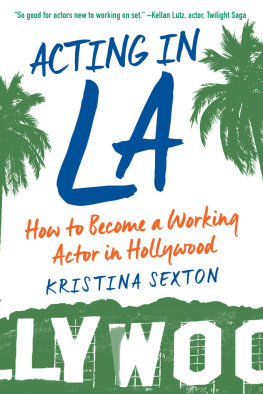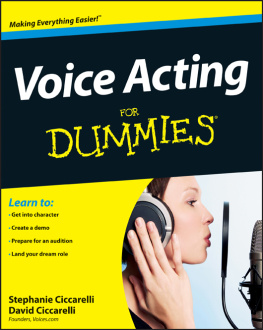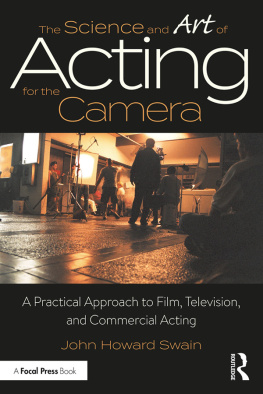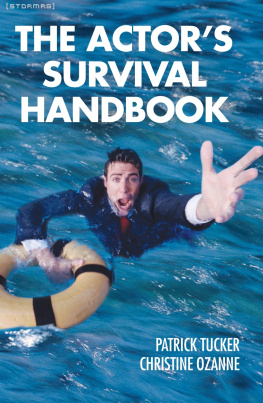Acting Face to Face 2: Emotional Alignment
HOW TO CREATE GENUINE EMOTION FOR TV AND FILM
By
John Sudol
Copyright 2015 by John Sudol.
All rights reserved. No part of this publication may be reproduced, distributed or transmitted in any form or by any means, including photocopying, recording, or other electronic or mechanical methods, without the prior written permission of the publisher, except in the case of brief quotations embodied in critical reviews and certain other noncommercial uses permitted by copyright law. For permission requests, write to the publisher at the contact info below.
info@actingfacetoface.com
facebook.com/languageoftheface
twitter.com/johnsudolstudio
Table of Contents
Special Acknowledgment
It is important for me to acknowledge that much of this book is inspired by and based on the work of many leading researchers in the field of emotions. I am particularly grateful to Dr. Paul Ekman. Without his influence and dedication to the science of emotions, I am uncertain of how much of my own work I would have realistically accomplished.
Theres no denying Ekmans lifelong work and research defined the human emotional experience. With much certainty, we now know why emotions occur, what they compel us to do, and what they look and feel like. I embarked on Dr. Ekman's seemingly open invitation to generate new ways to combine two powerful worlds: the science of emotion and the art of expression.
This second book is a direct result of my passion and respect for both worlds, combined with my many years of researching, exploring, and migrating the two.
Art and science have their meeting point in method.
Edward G. Bulwer-Lytton
Other books and online courses by John Sudol:
Ebook/Paperback/ Audio:
Acting: Face to Face 1: The Actors Guide to Understanding How Your Face Communicates Emotion for TV & Film
Emotion Training Courses:
www.emotiontrainingcenter.com
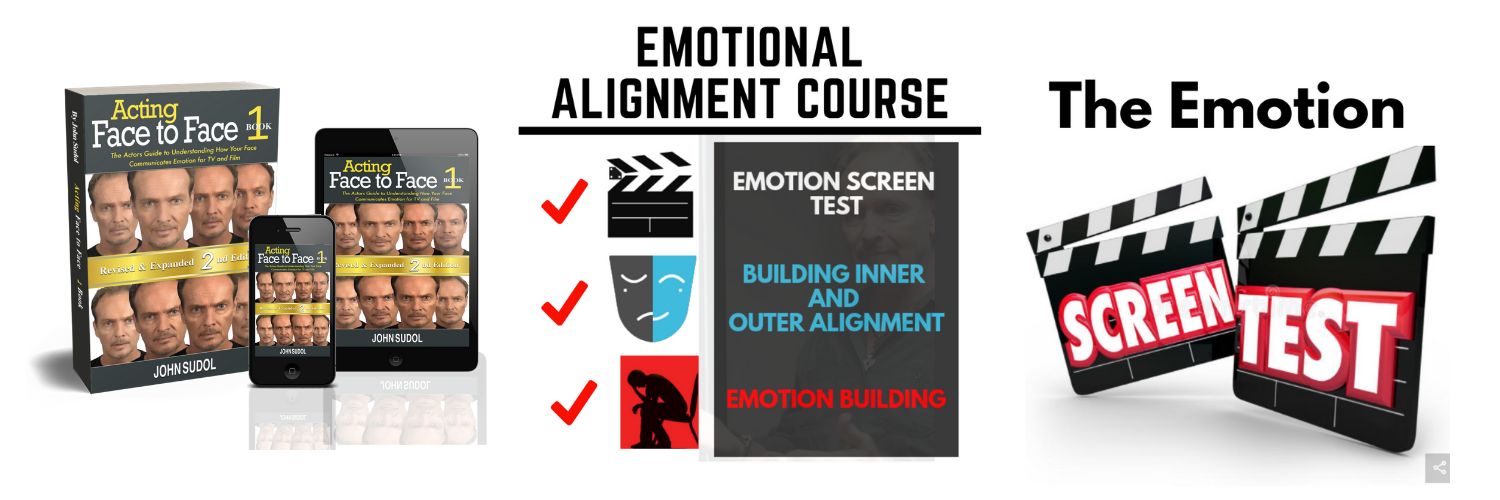
Introduction
Where weve been and where were going
Before we start on our new journey into Emotional Alignment, I think its important to first revisit the journey weve been on so far. Understanding the path weve been on will serve not only as a guide for what is to come, but also as the inspiration you will ultimately need to continue onward.
My first book, Acting: Face to Face (The Actors Guide to Understanding how your Face Communicates Emotion for TV and Film) set us in motion. The message contained within it slowly but surely started to change the beliefs, and ultimately the face, of on-camera acting. The book was born out of my own frustrations, needs, limitations and love for the craft of acting. Although I was a well-trained, working actor, when it came to on-camera work I always felt there was a tool missing from my toolbox: a way to create and control how and what my face was expressing. I ultimately learned that I wasnt the only one who felt this way. As it turns out, there are a great number of actors who share similar feelings.
Our initial journey set out to answer some very serious questions, like:
Why do certain actors have an easier time transitioning between stage and screen?
Why do people see you differently than how you see yourself and how critical is this awareness to your success?
Why does your face remain blank even though you feel youre experiencing emotion intensely?
Why does every thought, whether you want it to or not, register on your face?
What is the difference between the training you received for the stage and training required for on-camera acting?
In Chapter 1, I unveiled acting as an art of deception. To achieve deception the actor must know what the truth feels like in their body, sounds like in their voice and looks like on their face. Whatever your acting process is, inside out or outside in, if the audience doesnt believe in the world you have created game over.
In Chapter 2, I pointed out that there is a small percentage of actors that get the majority of on-camera acting work. I named this group the 5%. (As a side note, I have to say now that I was being very generous). This group may not necessarily be more talented; however, they are definitely doing something different than everyone else. Further observation revealed that they had a natural ability to create and control what their face was expressing. As a result, they were able to come up with real, recognizable, appropriate emotional facial reactions. They were also able to repeat what they created and do it on demand.
The other group I identified was the 20%. This group has the potential for on-camera success; however, when it comes to creating and controlling what their faces are expressing, this tool is either missing or isnt as reliable as it is for the 5%.
In Chapter 3, I began to unravel some of the on-camera acting mysteries. I introduced you to Dr. Paul Ekman, his research on emotions, and how it rocked my world. I shared with you what I had learned about the 7 universal emotions. I highlighted the universality of muscle groups, triggers, sensations and impulses for each. I also shared with you how emotions were revealed through the macro, micro and subtle expressions.
Ekmans research proved that we are all wired to express these 7 emotions with the same facial muscle groups, and that anywhere on the planet people will recognize Surprise, Fear, Anger, Disgust, Contempt, Sad and Happy.
This information about how the face communicates nonverbal emotional information ultimately led to me uncovering this missing link to on-camera acting and the development of what I call the Language of the Face. I pointed out that up until now, the on-camera actor only received training in two channels of nonverbal emotional communication: body and voice. The body and voice training serves the stage actor well; however, having only two channels of nonverbal emotional communication is limiting and often extremely frustrating for the on-camera actor who is constantly asked to come up with real, recognizable and appropriate emotional facial expressions.
What had been missing for the 20% wasnt a new way to use the old tools. It was acquiring the third channel of communication! Including the face during training, along with the other two nonverbal channels of communication, does more than just fill a void. It forms and completes what I call the Emotional Triad: body, voice and face. Honoring and offering this triad in the actors training fully prepares the actor to work in any venue: stage, commercial, print, TV or film.
Chapter 4 brought the 7 distortions (anything that interferes with the creating or revealing of what you intend) to light for the first time. If you did the work to see how these might be impacting your process, then you might recall them as: Your face, How youre wired, The culture you were raised in, Family idiosyncrasies, Your own psychology, Inappropriate emotional triggers and How you listen: literal vs. inferential .
In Chapter 5, I challenged some of the contemporary beliefs and tools that are offered to actors whose goals are to work on-camera. Those beliefs and tools Im referring to are: Making everything smaller, Bringing emotions through your eyes, Think the thought and the camera will pick it up, Just be honest. These beliefs and tools are widely accepted and refer to part of the actors on-camera training; however, for the 20%, they really dont offer a reliable solution to the challenges presented when auditioning or acting for the camera.
Next page
